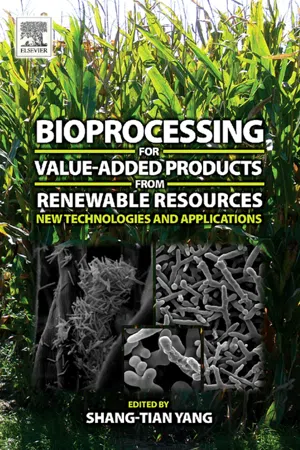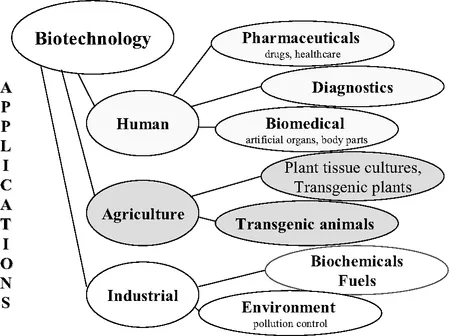
Bioprocessing for Value-Added Products from Renewable Resources
New Technologies and Applications
- 684 pages
- English
- ePUB (mobile friendly)
- Available on iOS & Android
Bioprocessing for Value-Added Products from Renewable Resources
New Technologies and Applications
About This Book
Bioprocessing for Value-Added Products from Renewable Resources provides a timely review of new and unconventional techniques for manufacturing high-value products based on simple biological material. The book discusses the principles underpinning modern industrial biotechnology and describes a unique collection of novel bioprocesses for a sustainable future.
This book begins in a very structured way. It first looks at the modern technologies that form the basis for creating a bio-based industry before describing the various organisms that are suitable for bioprocessing - from bacteria to algae - as well as their unique characteristics. This is followed by a discussion of novel, experimental bioprocesses, such as the production of medicinal chemicals, the production of chiral compounds and the design of biofuel cells. The book concludes with examples where biological, renewable resources become an important feedstock for large-scale industrial production.
This book is suitable for researchers, practitioners, students, and consultants in the bioprocess and biotechnology fields, and for others who are interested in biotechnology, engineering, industrial microbiology and chemical engineering.
·Reviews the principles underpinning modern industrial biotechnology
·Provides a unique collection of novel bioprocesses for a sustainable future
·Gives examples of economical use of renewable resources as feedstocks
·Suitable for both non-experts and experts in the bioproduct industry
Frequently asked questions
Information
Bioprocessing – from Biotechnology to Biorefinery
Publisher Summary
1 INTRODUCTION
2 INDUSTRIAL BIOTECHNOLOGY – HISTORY AND APPLICATIONS

| Year | Historical Events |
| 6000 B.C. | Alcoholic beverages, bread, and cheese made by fermentation |
| 1857 | Pasteur proves fermentation is caused by microorganisms |
| 1910 | Fermentation industry developed (fuel & solvent production) |
| 1923 | Citric acid produced by industrial fermentation |
| 1944 | Penicillin mass-produced for Normandy landings in WWII |
| 1953 | DNA structure elucidated |
| 1973 | Recombinant DNA makes genetic engineering possible |
| 1982 | First commercial recombinant protein product (human insulin) |
Table of contents
- Cover image
- Title page
- Table of Contents
- Contributors
- Preface
- Chapter 1: Bioprocessing – from Biotechnology to Biorefinery
- Chapter 2: Application of Genomic and Proteomic Data for Bioprocess Analysis and Optimization
- Chapter 3: Directed Evolution Tools in Bioproduct and Bioprocess Development
- Chapter 4: Metabolic Engineering – Applications, Methods, and Challenges
- Chapter 5: Amylase and Cellulase Structure and Function
- Chapter 6: Bioreactor Engineering
- Chapter 7: Membranes for Bioseparations
- Chapter 8: Bacterial and Yeast Cultures – Process Characteristics, Products, and Applications
- Chapter 9: Filamentous Fungal Cultures – Process Characteristics, Products, and Applications
- Chapter 10: Plant Cell and Hairy Root Cultures – Process Characteristics, Products, and Applications
- Chapter 11: Production of High-Value Products by Marine Microalgae Thraustochytrids
- Chapter 12: Nonconventional Biocatalysis for Production of Chemicals and Polymers from Biomass
- Chapter 13: Biocatalysis for Chiral Synthesis
- Chapter 14: Immobilized Cell Fermentation for Production of Chemicals and Fuels
- Chapter 15: Water-in-Oil Cultivation Technology for Viscous Xanthan Gum Fermentation
- Chapter 16: Extractive Fermentation for the Production of Carboxylic Acids
- Chapter 17: Fungal Fermentation for Medicinal Products
- Chapter 18: Solid State Fermentation and Its Applications
- Chapter 19: Algal Photobioreactor for Production of Lutein and Zeaxanthin
- Chapter 20: Power-Generation from Biorenewable Resources: Biocatalysis in Biofuel Cells
- Chapter 21: Biological Production of Hydrogen from Renewable Resources
- Chapter 22: Bioconversion of Whey Lactose into Microbial Exopolysaccharides
- Chapter 23: Microbial Production of Bioplastics from Renewable Resources
- Chapter 24: Industrial Applications for Plant Oils and Lipids
- Chapter 25: Value-Added Products from Animal Manure
- Index